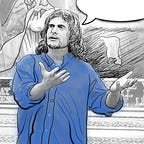Magic Horses
Native Americans were the first people on the planet to ever get a glimpse of a horse. When the first Native Americans traversed the exposed land bridge across the Bering Strait they entered a land which had many strange and beautiful animals but no humans. These large mammals included mammoths, camels, saber toothed cats, and prehistoric horses; tiny ponies which were no more than waist high. The same land bridge which allowed human beings to migrate into North America also let the first horses enter into Asia. The horses encountered by these first Native Americans were simply too small to be domesticated and ridden.
Ecological conditions on the North American continent quickly changed as the Ice Aged ended and the glaciers retreated. The land bridge of Berengia sank back beneath the ocean. A large group of animals, specifically designed for the Ice Age, went extinct in the hotter drier conditions. This included the tiny prehistoric ponies of North America. The ancestors of all modern horses came from a Mongolian horse, migrants from North America. It is ironic that Native Americans, the first people on the planet to glimpse horses, did not get a second look for over 15,000 years.
When Cortes landed on the shores of Mexico with an expedition which included
16 horses; these equines were the first to put their hooves back on the North American mainland. The De Soto expedition through the American south in 1539 was a disaster to all whom it touched and an example of this failure was that out of 214 horses who started with the expedition only 22 returned. Some perished in battle, others from hardships, but many were stolen. The peoples of the southeast were the first mounted Native American warriors.
In 1540, the Coronado expedition trudged into the American southwest from Mexico City with an expedition which included over 1600 horses. The expedition chronicler, a man named Castaneda wrote that many of the horses disappeared in the vast Texas plains. Most experts agree that tribes of the southwest; Navajo, Comanche, Pueblo, and Apache, started riding horses by 1550. By 1664 there were written accounts of the people of the Plains coming to the southwest trade fairs with the intention of swapping captives and buffalo robes for horses. Their reputation on horseback and most importantly, their reputation as horse traders earned the Cheyenne the nickname of Painted Pony People. The oral traditions of many different Indian nations credit the Cheyenne with the introduction of the horse.
For many peoples, such as the Sioux or Apache, the horse completely revolutionized their culture. The Lakota chief American Horse told the legend of the Thunder Horse. The Thunder Horse was a huge and monstrous beast who only came to earth during the fiercest of lightning storms. While the tempest raged, the Thunder Horse would hunt buffalo, killing the shaggy beasts with a single blow of his massive hooves.
There was one summer that an entire village was in danger of starvation. All attempts to hunt game had ended in futility. A drought had left the crops parched and withered. The drought was ended with a terrible storm which filled the sky with thick black clouds, tornadoes, huge hail stones, and a thousand spears of lightning. The Thunder Horse dropped down in a terrible avalanche of speed, muscle, and fury. As the wind wailed with roars of thunder, the magic equine drove a herd of buffalo right through the center of the village, the people were saved.
The only domesticated animals that Native Americans possessed before the arrival of Europeans were dogs so perhaps it is only natural that the word for horse in most native tongues includes the word dog somewhere. The Snake called the horse “Big Dog.” “Ponaka Nikita” or elk like dog was the Blackfoot name. The Sioux referred to the horse as “Shonka Wakon” or Medicine Dog. The Comanche showed their respect by naming the horse Dog God.
A sad example of the importance of the horse in colonial North America took place in 1698. That is when the first public hanging took on the continent. Spanish governor Juan De Onate sentenced two Pueblo men to be hung till death as punishment for the capital offense of horse thievery. Can you imagine being sentenced for execution for the crime of trying to steal, tame, and ride God?
